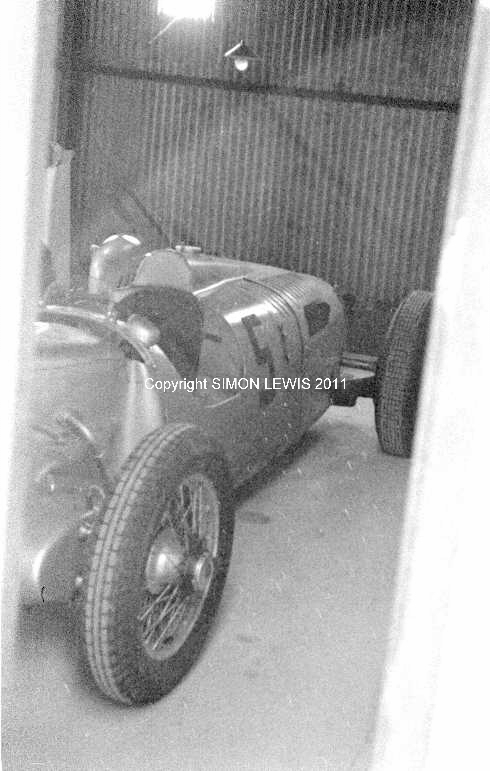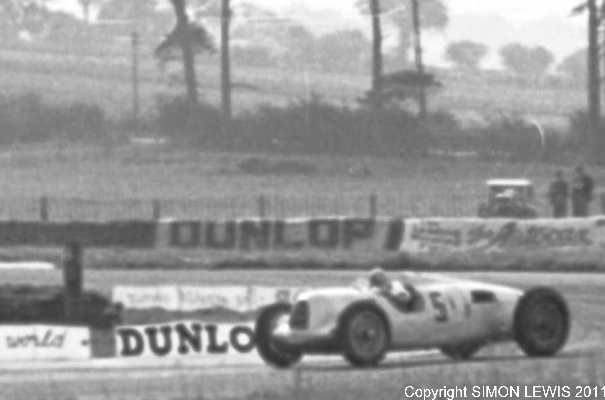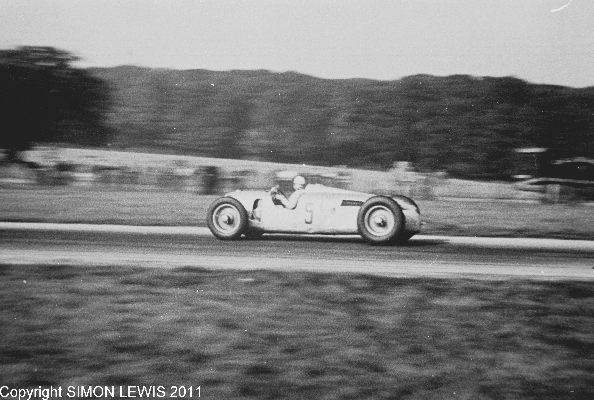As promised, I go on with this story. And today's topic is:
The Kharkov – a rebuilt Auto Union?Oh, this amazing story is probably the greatest Alexandrov's hoax.
But before I'll try to debunk this myth, first I'd like to work out, what Soviet car does he actually mean? Because it's absolutely not clear from his statements.
On page 11 in his
Oldtimer-Markt article he writes: "The first Kharkov, built by autodidact Nikitin and fitted with engine of Pobeda production car, strikingly resembled the streamlined Auto Union". Several results and dates quoted (November and December 1950) confirm that he really describes the earliest Nikitin's car. Then without any break Alexandrov moves to the speed shown in May 1951 and explains further that it was achieved by Kharkov 3, which mainly differed from the previous version through the more streamlined cockpit. His theory is well supported with two pictures on page 12, which apparently show the 1950 Kharkov (according to Alexandrov – a rebuilt Auto Union) and the later Kharkov 3 ("also called the Avangard").
One of these shots appears in the book as well, on page 105. And on pages 104-106 the story from
Oldtimer-Markt is being told once again. Alexandrov counts Nikitin's achievements in 1950/51, "recognizes" the Kharkov as a former German racecar and expresses doubt whether it was possible "to build an Auto Union copy so quickly, almost overnight". Model indices aren't used here as he's obviously talking about slightly different variants of the same design.
Until now everything is OK. But on page 154 Alexandrov informs us that Kharkov 2 (mentioned here for the first time!) "had nothing in common with Kharkov 1" and exactly in this Kharkov 2 some parts of the streamlined Auto Union were used, if not the whole car! A bit later, on page 159 he tells something completely different: "From [Auto Union] components Nikitin has supposedly built his Kharkov 1".
A confusion? Oh yes, and very big! Fortunately it's pretty easy to untie this knot if one is familiar with Nikitin's designs.
He built his very first record car, the Kharkov, in the fall of 1950, using flat frame of pre-war GAZ M1 while both axes, steering, engine (in-line four, 2481 ccm, 70 hp) and gearbox came from written off GAZ 20 Pobeda. Bulky two-seater looked rather like an aircraft's external fuel tank and resembled neither Zvezda (page 104) nor Auto Union.
 Source: Lev Shugurov archive
Source: Lev Shugurov archiveNikitin soon reworked the cabin and shortened long front-end so from now on his car became Kharkov 2. However road-holding was still far from perfect as the chassis wasn't rigid enough and the car suffered from longitudinal swinging.
 Source: Dmitriy Dashko archive
Source: Dmitriy Dashko archiveThat's why in the winter of 1950/51 Nikitin started working on a brand-new design, with low streamlined body and engine placed behind the driver. He again opted for Pobeda internals – power plant, transmission, suspension, brakes, wheels, rear axle, steering... No wonder, there was practically no choice back then. It took him several months (and not "one night"!) to build the car. No local factories participated. And there certainly were no orders from the Communist Party of Ukraine (page 105) – that's just ridiculous. Of course Nikitin wasn't alone. He was helped by enthusiasts like himself – depot co-workers, students of the technical institute, members of a local automobile club and those of the voluntary sports society
Trud... As far as authorities are concerned some of them expressed against involving young people in those "exotic and dangerous amusements", to say nothing of any support.
Kharkov 3 made its debut in May 1951 and in the course of later modifications got Kharkov 4 and Kharkov 5 names. On 26 October Nikitin speeded it up to 202,179 kph and became first man in the Soviet Union to pass 200 kph mark. (What's more, he also broke the record of 202,13 kph set by Benz works driver Franz Hörner near St. Petersburg... on 27 May 1913, i.e. before Socialist Revolution.) Exactly this glory moment is depicted on the title page of
Knowledge is power magazine, issue 12/1951 (caption on page 155 incorrectly calls it
Science and life).

Indeed, it's quite obvious that this car was created with streamlined Auto Union in mind. At least they both look very similar. Well, borrowing good ideas is not that rare thing in motoring industry. And technical masterpieces like Silver Arrows inspired not only Soviet designers. For example, the 1938 MG EX135 clearly plays theme of the Mercedes which won the famous Avus race last year...
 Photo: Harold Clements / Getty Images
Photo: Harold Clements / Getty Images...while the 1951 Cooper T17 looks like an Auto Union scale model!
 Source: "Cooper Cars" by Doug Nye
Source: "Cooper Cars" by Doug NyeStill was Kharkov 3 in fact just a rebuilt / camouflaged Auto Union? My answer is NO!
Take a look at the pictures below. Note different wings shape, ragged wheel arches, stretched rear-end, overall rough finish. Looks like garage-made special – too inaccurately for a product of Auto Union race department. Besides that there are only four exhaust pipes on the right side and not a single one on the left – thus no V16 inside.
 Source: Lev Shugurov archive
Source: Lev Shugurov archive Photo: Vladimir Dovgyallo
Photo: Vladimir DovgyalloBy the way, some sources identify the car on the second picture as Dzerzhinets but I'm fairly sure it actually shows Kharkov 3 with fully enveloped cockpit and wheel arches.
Another argument lies in a simple comparison of dimensions (figures for German car are given in brackets).
Length – 6200 (5520) mm
Width – 1300 (1835) mm
Height – 950 (1060) mm
Wheelbase – 3200 (2910) mm
Front/rear track – 1125/966 (1420/1420) mm
All in all Kharkov 3 was longer, narrower and somewhat lower than streamlined Auto Union. This resulted in extremely different proportions.
And last but not least. Nikitin was WW2 veteran and earned numerous awards – three orders (of the Patriotic War, of Red Star, of Glory) and three medals (For Bravery, For Combat Services and For Stalingrad's Defense). Do you really think this man would have used fascist machinery for his records? The more so, as sporting rules prohibited to race anything but Soviet-made – the fact that Alexandrov continually underlines in his book.
Let's proceed. Previously mentioned picture of the 1950 Kharkov (page 12 in article, page 105 in book) in fact shows the 1966 (!) gas turbine powered KHADI 7 – one can clearly see the huge turbine nozzle. Incidentally this car survived in Ukraine so everyone can come to Kharkov Technical University and find out that it has nothing to do with Auto Unions except for some similarity in appearance.
And what's with the Avangard? Oh, that's another nonsense created by Alexandrov. Because it was entirely different, albeit AU-similar car. It was built in 1951 by Nikitin's townsman, Ivan Pomogaibo. His car has was initially called the Dzerzhinets and then was renamed as the Avangard. You can see it on page 12 in
Oldtimer-Markt article and on the following pictures.
 Source: Nikolai Markov archive
Source: Nikolai Markov archive Source: Nikolai Markov archive
Source: Nikolai Markov archiveIn terms of design it was reminiscent of Kharkov 3. However it was equipped with the engine of GAZ 51 truck (in-line six, 2982 ccm, 150 hp) and weighed ca. 1500 kg – almost twice as much as Kharkov 3 (850 kg). On 9 November 1952 the Dzerzhinets reached 230,665 kph – and that remained its main success, despite the car was in use until 1963.
Bulky and heavy, Pomogaibo's car is a bit closer to the Auto Union when it comes to proportions. Yet you have to be very imaginative to consider the Avangard being modified Silver Arrow, don't you? And here you've got the dimensions comparison.
Length – 5500 (5520) mm
Width – 1980 (1835) mm
Height – n/a (1060) mm
Wheelbase – 2845 (2910) mm
Front/rear track – 1120/960 (1420/1420) mm
Remarkable is that Alexandrov didn't even mention the Avangard in his book. Instead in 2008 he started a thread on Russian BB where accused Pomogaibo of rebuilding the Auto Union but said not a word about Nikitin's Kharkov!
The only possible conclusion I can draw is that Alexandrov has been tangled in his own lies. This brings up the question: which components of the German cars were in fact used in Soviet racing and record cars, if any? But I will answer it in the next part.
To be continued.
Edited by Pavel Lifintsev, 06 March 2011 - 13:02.











































